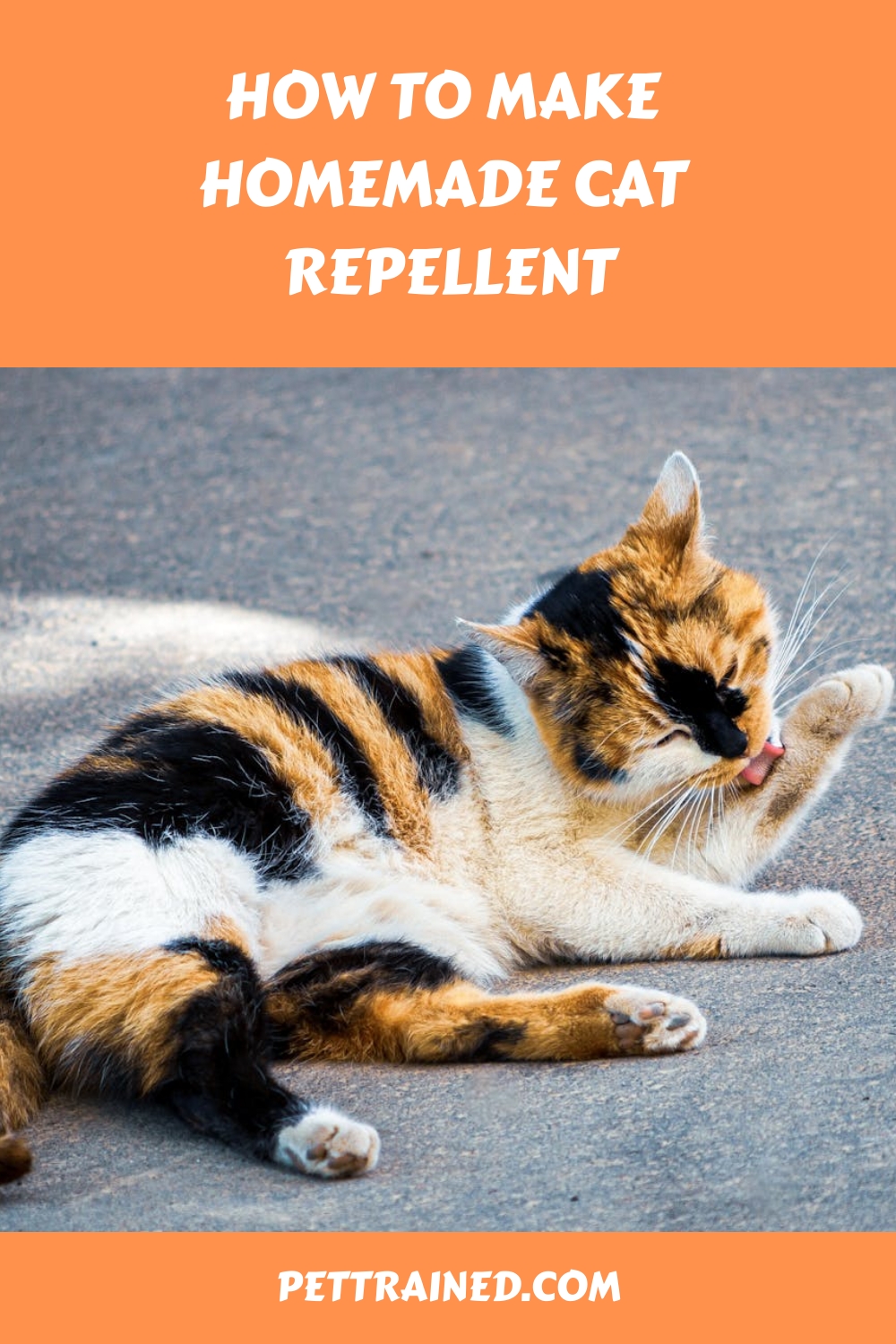
To create a homemade cat repellent, use essential oils like lavender, eucalyptus, or citrus, which cats find unpleasant.
Dilute one drop of oil per tablespoon of water to guarantee safety.
Alternatively, mix equal parts water and vinegar, or combine 10-15 drops of citrus essential oil with one cup of water for a potent spray.
Herbal deterrents such as rosemary, peppermint, and citrus peels can also work.
Application consistency is vital; reapply after rainfall for sustained efficacy.
Utilizing these methods can yield effective results, and exploring further will provide thorough insights into feline behavior and repellent techniques.
This post contains affiliate links. However all the information provided on this site are my own honest opinions. See more in Disclaimer.
Table of Contents
Key Takeaways

- Mix one drop of essential oil (eucalyptus, lavender, or citrus) with one tablespoon of water. Spray this mixture in targeted areas to repel cats.
- Combine equal parts vinegar and water. Spray on areas frequented by cats to deter them with the pungent scent.
- Dissolve one tablespoon of cayenne pepper in one cup of boiling water. Strain the mixture and spray around the area to repel cats.
- Use citrus peels or citrus essential oils mixed with water to create a natural cat deterrent. Cats dislike the scent of citrus.
Understanding Cat Behavior
To effectively create a homemade cat repellent, it’s vital to first understand the intricacies of feline behavior and the stimuli that influence their actions.

Felines are driven by a complex set of instincts and environmental cues. One primary instinct is territory marking, which involves behaviors like scratching, spraying, and rubbing their scent glands against objects.
This is how they communicate ownership and establish boundaries.
To deter cats from certain areas, you’ll need to counteract these natural behaviors. Begin by recognizing the significance of olfactory signals in feline communication.
Cats have a highly developed sense of smell, which they use to detect pheromones left by other cats. These pheromones are imperative in territory marking, as they provide information about the cat’s identity and reproductive status.
Understanding these behaviors allows you to create a repellent that disrupts these olfactory cues. For instance, identifying and cleaning areas where cats have marked their territory can be an effective first step.
Additionally, introducing substances that cats find unpleasant can discourage them from returning to these spots.
Now here’s how to make homemade cat repellent:
1. Essential Oils Repellent
You’re likely aware that certain essential oils can act as effective cat repellents due to their potent aromatic compounds.
When formulating your mixture, consider oils like lavender, eucalyptus, and citrus, which are known to deter feline behavior.
Guarantee proper dilution and application techniques to maximize efficacy and safety.
Common Essential Oils
Harnessing the power of vital oils like citronella, lavender, and eucalyptus can effectively deter cats from unwanted areas due to their strong, aversive scents.
These oils interact with feline olfactory receptors, producing a repellent effect. However, it’s important to prioritize essential oil safety and cat health when employing these substances.
Cats possess a unique metabolic system that makes them more vulnerable to essential oil toxicity. Therefore, using these oils in diluted forms is paramount to mitigate potential adverse reactions.
Citronella oil, derived from lemongrass, contains compounds such as citronellal and geraniol, which are known for their repelling properties.
Lavender oil, with its primary component linalool, has a scent that cats find particularly unappealing. Eucalyptus oil, rich in eucalyptol, serves as another potent deterrent.
Despite their efficacy, you should always confirm these oils are diluted to safe concentrations, typically one drop of essential oil per tablespoon of water, to avoid health risks.
Additionally, monitoring your cat for any signs of distress or allergic reactions, such as excessive drooling, vomiting, or respiratory issues, is essential.
This vigilance guarantees that while you deter cats from certain areas, you also maintain their overall well-being.
Mixing and Application
When mixing an essential oils repellent, guarantee you use a precise ratio of one drop of essential oil per tablespoon of water to maintain safety and efficacy.

This ensures the repellent remains potent without causing harm to the environment or non-target species.
Begin by selecting a repellent recipe that includes essential oils known for their deterrent properties, such as eucalyptus or peppermint.
Use a graduated cylinder for accurate measurement of water to achieve the correct dilution.
Incorporate mixing techniques that guarantee uniform dispersion of the essential oil within the water. A common method is using a high-speed blender or a vortex mixer for several minutes until a homogenous mixture is achieved.
Once your solution is thoroughly mixed, transfer it into a spray bottle using a funnel to avoid spillage.
Apply the repellent to targeted areas where you want to deter cats, such as garden beds, patios, or entry points.
Reapplication every few days is recommended, especially after rain, to maintain effectiveness.
Trending in Cats:
2. Citrus-Based Solutions
Citrus-based solutions exploit cats’ natural aversion to the scent of citrus fruits, making them an effective and non-toxic repellent.
Cats inherently dislike citrus scents, which is rooted in their olfactory sensitivity and specific feline preferences. This aversion can be strategically utilized to deter them from certain areas.
To create a citrus-based repellent, you’ll need essential oils derived from citrus fruits such as oranges, lemons, or limes. These oils contain high concentrations of limonene and linalool, compounds known for their repellent properties.
Mix 10-15 drops of citrus essential oil with one cup of water in a spray bottle. Shake the mixture thoroughly to guarantee even distribution.
Spray this solution on surfaces you wish to protect from cats. Focus on areas like furniture, garden beds, or entry points. Reapply the solution every few days or after rainfall to maintain its efficacy.
The strong citrus scent will deter cats without causing them harm, aligning with humane pest management practices.
Ascertain you avoid using undiluted citrus oils directly, as high concentrations can be overwhelming and potentially harmful to both cats and humans.
Proper dilution guarantees safety while effectively leveraging the natural deterrent properties of citrus.
3. Vinegar and Water Spray
Vinegar and water sprays exploit acetic acid’s pungent scent to serve as effective feline deterrents. Vinegar’s properties, particularly its high concentration of acetic acid, create an unpleasant olfactory environment for cats.
This sensitivity to strong odors makes vinegar an excellent candidate for a homemade repellent.
To formulate this solution, you’ll need to combine equal parts of vinegar and water. The water’s effectiveness in this mixture dilutes the vinegar to a concentration that’s potent enough to deter cats without causing harm to surfaces or plants.
For instance, a 50:50 ratio guarantees the acetic acid remains at an ideal level while still being safe for use around your home and garden.
When applying this spray, target areas frequented by cats, such as garden beds, doorsteps, or any specific indoor spots.
Confirm thorough coverage, as the effectiveness diminishes if the scent isn’t pervasive. It’s advisable to reapply the spray every few days or after rainfall to maintain its deterrent effect.
4. Herbal Cat Deterrents

When considering herbal cat deterrents, you should focus on popular options like lavender, rosemary, and citrus peels known for their efficacy.
Guarantee you apply these herbs safely, avoiding direct contact with pets to prevent adverse reactions.
Assess their effectiveness and understand that the duration of repellent action varies by herb and environmental factors.
Popular Herbal Options
Many herbal cat deterrents leverage the strong scents of specific plants to create an environment that’s unappealing to felines.
When considering herbal safety and plant selection, it’s vital to choose species that are non-toxic to cats yet effective in repelling them. These plants often possess volatile oils and compounds that cats find offensive.
Here are some of the most efficacious herbal options:
Lavender: Known for its calming effects on humans, lavender’s strong aroma can be a deterrent for cats. The plant’s essential oils contain linalool and linalyl acetate, which are particularly repulsive to feline olfactory senses.
Citronella: Commonly used as an insect repellent, citronella also works against cats. The active ingredient, citronellal, interferes with a cat’s scent receptors.
Rue (Ruta graveolens): This herb has a potent smell that cats dislike. The plant contains alkaloids and essential oils that contribute to its strong odor.
Rosemary: With its robust fragrance, rosemary deters cats effectively. Its essential oil, rich in camphor and cineole, acts as a natural repellent.
Peppermint: The high menthol content in peppermint oil is intolerable to cats, making it a powerful deterrent.
Safe Application Tips
To guarantee the safety and effectiveness of herbal cat deterrents, it is crucial to apply them in a manner that maximizes their repellent properties while minimizing any potential risks to your cat or household.

When using natural alternatives, you need to take into account specific safety precautions to make sure that these substances don’t harm your pet or damage your home environment.
First, always conduct a patch test on a small, inconspicuous area to check for any adverse reactions. In addition, verify that you dilute potent essential oils to avoid any toxic effects.
Finally, regularly monitor the treated areas to confirm that the deterrent remains effective and safe.
Here’s a quick reference table for safe application tips:
| Safety Precaution | Description |
|---|---|
| Patch Test | Test a small area to check for reactions. |
| Dilution | Dilute essential oils to safe concentrations. |
| Frequency of Use | Apply deterrents consistently but not excessively. |
| Monitoring | Regularly inspect treated areas for effectiveness and any signs of damage. |
Effectiveness and Duration
Evaluating the effectiveness and duration of herbal cat deterrents requires a methodical approach to determine their reliability in various environments.

To optimize these deterrents, you need to understand cat sensitivity to specific herbal compounds. Cats have highly developed olfactory systems, making them particularly susceptible to certain scents like citrus, eucalyptus, and lavender.
These herbal repellents can be quite effective, but their longevity varies based on several factors.
To guarantee maximum repellent longevity, you should consider environmental exposure, as sunlight, rain, and wind can reduce the efficacy of herbal repellents. Reapply frequently in outdoor settings.
The concentration of herbal extracts is also crucial. Higher concentrations generally offer prolonged deterrence, but be cautious of potential toxicity.
Additionally, the application method matters; sprays tend to dissipate faster than solid forms like sachets or potpourri.
Cat behavior is another variable to consider. Some cats may exhibit desensitization over time, requiring periodic changes in the type of herb used.
5. Homemade Pepper Spray
Creating a homemade pepper spray involves combining specific ingredients that effectively deter cats without causing harm.

To guarantee pepper spray effectiveness, you’ll need to use a scientifically-backed formula. Start by mixing water with cayenne pepper or chili powder, both known for their pungent capsaicin content.
Capsaicin is the active component that makes these spices an effective natural pest control agent. To prepare a basic solution, dissolve one tablespoon of cayenne pepper in one cup of water.
Boil this mixture to release the capsaicin and then let it cool.
Strain the liquid to remove any solid particles that could clog your spray bottle. Next, add a few drops of dish soap to help the solution adhere to surfaces.
This step enhances the longevity of the repellent’s effects.
Transfer the solution into a spray bottle and apply it to areas where you want to deter cats. Make sure you reapply the mixture after rainfall or heavy watering, as water can dilute its effectiveness.
Always test a small area first to avoid potential damage to plants or surfaces.
This method provides a humane, environmentally friendly way to keep cats at bay.
6. Physical Barriers and Deterrents
While homemade pepper sprays offer a chemical deterrent, physical barriers and deterrents provide an additional layer of protection to keep cats out of unwanted areas.
These methods can be particularly effective when integrated into an all-encompassing cat repellent strategy. By employing various physical barriers and deterrent technologies, you can create an environment that’s less inviting to felines.
Utilize the following physical deterrent methods to enhance your cat-repelling efforts:
Fencing Options: Install cat-proof fencing that either curves inward or has rollers at the top to prevent climbing.
Motion Sensors: Deploy motion-activated sprinklers or ultrasonic devices to startle and discourage cats from entering specific areas.
Prickly Surfaces: Use mats or strips with plastic spikes to create uncomfortable surfaces for cats without causing harm.
Netting: Place netting over garden beds or other areas to make them inaccessible to cats.
Aromatic Plants: Plant cat-repelling flora such as lavender, rosemary, or rue to create natural borders that deter cats.
Frequently Asked Questions on How to Make Homemade Cat Repellent

Yes, homemade cat repellents can be safe for your garden plants if you use appropriate repellent ingredients. Consider plant safety by opting for natural substances like citrus peels or vinegar. These won’t harm your plants.
If your cat ingests the repellent, immediately monitor for cat toxicity symptoms like vomiting, lethargy, or seizures. Contact emergency vet care without delay. This guarantees prompt treatment and minimizes potential health risks to your pet.
You should reapply homemade cat repellents every 3-5 days to maintain efficacy. The reapplication frequency depends on environmental factors and the persistence of effective ingredients like citrus oils or vinegar. These ingredients can degrade over time, necessitating regular reapplication.
Have you ever wondered if homemade repellents can be used indoors? Yes, they can. Guarantee indoor safety by using non-toxic ingredients. Repellent effectiveness indoors depends on proper formulation and consistent application to maintain a cat-free environment.
Yes, rain impacts repellent longevity considerably. Water-soluble components wash away, reducing efficacy. To mitigate rain’s effects, reapply repellent after heavy precipitation. Alternatively, use water-resistant formulations for prolonged protection.
Conclusion

Incorporating these homemade cat repellents into your routine is both effective and humane.
While you might worry about your home’s scent, rest assured that essential oils and citrus-based solutions can be pleasantly aromatic.
By understanding cat behavior and using scientifically-backed deterrents like vinegar sprays and herbal mixtures, you’ll create an environment that’s unappealing to cats but comfortable for you.
Implementing these methods guarantees a harmonious coexistence without resorting to harmful measures.













